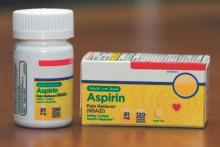Many patients aged 50-59 years should start low-dose aspirin for the primary prevention of cardiovascular disease and colorectal cancer, according to the U.S. Preventive Services Task Force’s updated clinical practice guideline on aspirin therapy, published online April 11 in Annals of Internal Medicine.
The evidence is clear that the benefits outweigh the potential harms of low-dose aspirin in this age group if patients have a 10% or greater 10-year cardiovascular disease (CVD) risk, are not at increased risk of bleeding, have a life expectancy of at least 10 years, and are willing to take the treatment for at least 10 years, said Dr. Albert L. Siu and his associates in the USPSTF.
The organization based this guideline on 2 systematic reviews of the literature, updating its 2009 review on aspirin therapy to prevent cardiovascular disease and updating its 2007 review on aspirin therapy to prevent colorectal cancer. The findings from these reviews of the current evidence were used to develop a decision-analysis model to weigh the benefits and harms of treatment in various patient groups defined by age, gender, and risk factors.
Recent studies of primary prevention of CVD, which included 118,445 participants, “consistently demonstrated effectiveness of aspirin in preventing nonfatal MI and stroke.” Pooled analyses showed that low-dose aspirin reduced nonfatal MI and coronary events 17% (risk ratio, 0.83) and that any aspirin dose reduced them 22%. Low-dose aspirin also reduced all-cause mortality risk (RR, 0.95) in pooled analyses.
Aspirin therapy also reduced the risk of colorectal cancer, but this benefit didn’t appear until after 5-10 years of treatment. Three trials reported a 40% reduction (RR, 0.60) after 10-20 years of daily low-dose aspirin.
On the other side of the equation, major GI bleeding increased by 65% among aspirin users when the data from 15 CVD prevention trials were pooled. Similarly, pooled analyses showed a 33% increase in hemorrhagic stroke among aspirin users, compared with nonusers.
The benefits of low-dose aspirin were highest and the harms were lowest in patients aged 50-59 years, hence the first recommendation in the new guideline. In patients aged 60-69 years, the benefit-to-harm balance isn’t as clear-cut, so the decision to initiate or continue aspirin therapy in this age group must be made on an individual basis. “Some adults [at this age] may decide that avoiding an MI or stroke is very important and that having a GI bleeding event is not as significant. They may decide to take aspirin at a lower CVD risk level than those who are more concerned about GI bleeding. Adults who have a high likelihood of benefit with little potential for harm should be encouraged to consider aspirin use.
“Conversely, adults who have little potential of benefit or high risk for GI bleeding should be discouraged” from taking aspirin therapy, the investigators said (Ann Intern Med. 2016 Apr 11. doi: 10.7326/M16-0577).
The task force found that current evidence is insufficient to assess the balance of benefits and harms regarding aspirin therapy for adults younger than age 50 or older than age 70. In the latter group in particular, the picture is complicated by the effects of age, use of other medications, and concomitant illness. However, since cardiovascular risks are increased after age 70 and the incidences of MI and stroke are relatively high, the benefits of preventive aspirin could be substantial in this age group, said Dr. Siu of Icahn School of Medicine Mount Sinai, New York, and the Veterans Affairs Medical Center, the Bronx, and his associates.
The USPSTF guideline generally accords with existing recommendations from the American Heart Association, the American Stroke Association, the American Diabetes Association, the American Academy of Family Physicians, and the American College of Chest Physicians. At present, the American Cancer Society doesn’t have recommendations for or against aspirin therapy; the American Gastroenterological Association and the National Comprehensive Care Network “limit their recommendations to patients who are at increased risk for colorectal cancer,” Dr. Siu and his associates added.
Copies of the guideline and of the supporting literature reviews and the decision-analysis tool are available at www.uspreventiveservicestaskforce.org.


